The captain of an Air Niugini Boeing 737-800 that crashed while attempting to land at Chuuk on 28 September 2018 became fixated with trying to land the aircraft, ignoring several automated warnings that the aircraft was below the glidescope and had an excessive sink rate.
The final report into the fatal accident of the aircraft, registered P2-PXE, by Papua New Guinea’s Accident Investigation Commission (AIC) concluded that the aircraft was unstable in its approach, and the co-pilot should have taken control of the aircraft and initiated a missed approach, in accordance with the operator’s standard operating procedure manual.

Boeing 737-800 P2-PXE landed short of the runway in Chuuk lagoon on 28 September 2018
Lt Zach Niezgodski/AP/REX/Shutterstock
“The pilots’ actions and statements indicated that they had lost situational awareness from 625 ft on the approach and their attention had become channelised and fixated on completing the approach and landing the aircraft.”
It notes that the pilots failed to respond to 16 aural alerts from the enhanced ground proximity warning system (EGPWS), “pull up” visual warnings at the bottom of the primary flight display, and indications from the PAPI that the aircraft’s approach angle was too high, choosing instead to continue the unstable approach.
The pilot-in-command also reported that there was no visibility for the last 30 seconds of the flight due to encountering a small storm cell.
Nonetheless, the report notes that under Air Niugini’s operating procedures, the co-pilot should have intervened earlier.
“The co-pilot was completely unaware of the hazardous situation unfolding and did not challenge the PIC and attempt to take control of the aircraft from the PIC and execute a go-around, in accordance with company instructions that require taking over when an unsafe condition exists.”
As a result, the aircraft impacted the water of Chuuk Lagoon around 1,500ft (460m) short of the runway threshold, deflecting across the water several times and turning clockwise before coming to rest partially submerged.
A total of 46 occupants were evacuated from the aircraft, including six that passengers that sustained serious injuries. Most passengers were rescued by local boats, and some assisted by US Navy divers that were in the area.
There was one fatality, which a post-mortem concluded was due to injuries from the force of the impact with the water. The body retrieved three days later by local divers.
The AIC made 12 recommendations to Air Niugini, mostly relating to training on evacuations, safety placards and other safety deficiencies, which were addressed and subsequently closed off by the Commission.
However, a recommendation to Honeywell that the EGPWS be upgraded to include a continuous “pull up” aural and primary flight display warning replace the “sink rate” warning below 500ft radio altitude remains open. Discussions are continuing with the US Federal Aviation Administration, National Transportation Safety Bureau and the manufacturer over the matter, it adds.
Interestingly, the report from the AIC included a comment from the NTSB staff involved in the investigation largely dismissing the recommendation for changes to the EGPWS alerting system.
“NTSB staff disagrees that an additional warning would have been effective in alerting the crew,” the report reads.
It adds that the crew’s multiple failures to adhere to the system’s warnings, failure to follow correct procedures and lack of situational awareness “demonstrate that any additional guidance, alert, or warning would be similarly disregarded by the flight crew and ineffective in preventing the accident.”
Source: Cirium Dashboard


























